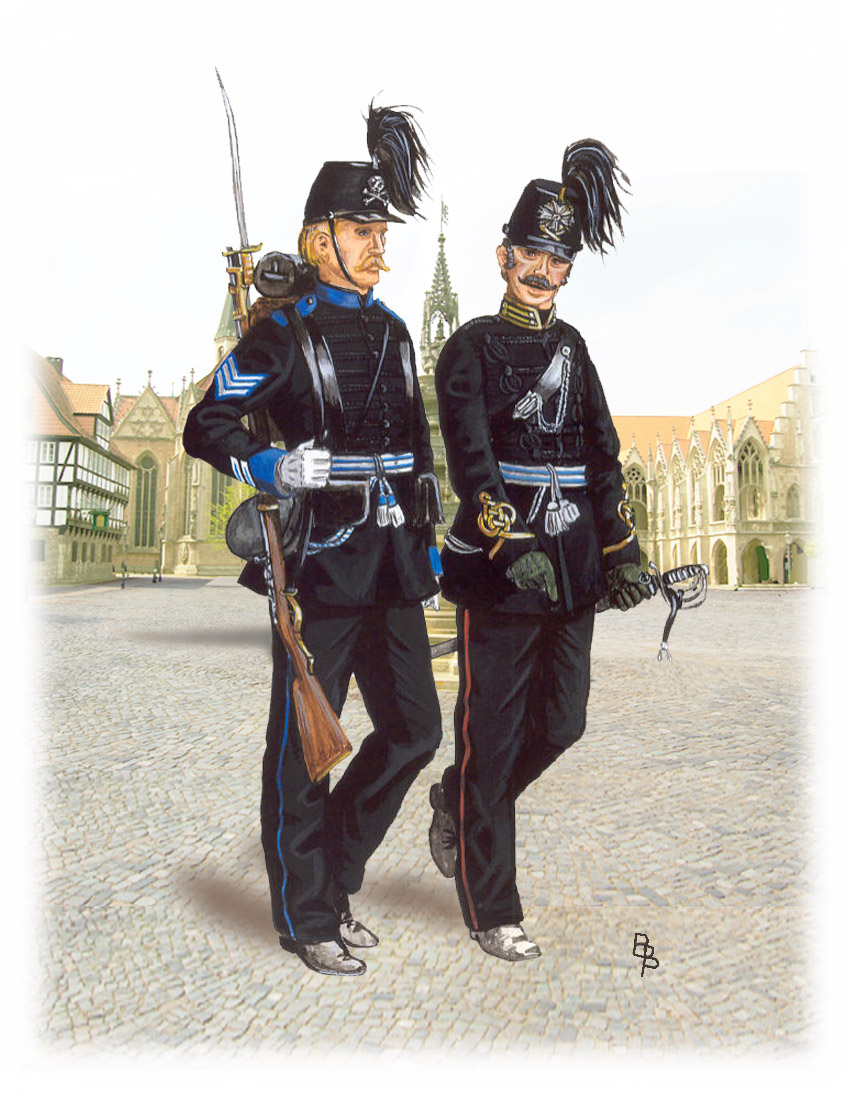THE ARMY OF BRUNSWICK
1866
In 1866 Brunswick was a small Duchy of less than 350 square miles and a population of about 315,000. It comprised four separated territories bordering Prussia and Hanover. For much of its history it had allied itself primarily with Hanover with strong family connections and often with Prussia. As the Principality of Brunswick-Wolfenbüttel It provided troops to these alliances in most conflicts of the eighteenth century including the Seven Years War. In 1806 during the Napoleonic Wars the Duke of Brunswick was killed at the Battle of Jena and the duchy was absorbed into the Kingdom of Westphalia. His son Frederick William with his troops resisted the French and escaped capture taking his troops (now clothed in black) to England. This corps of Brunswick-Oels (known unsurprisingly as the “Black Corps”) fought in the Peninsular War with distinction despite having to replenish its ranks with dubious recruits from all over Europe. In 1813 after Napoleon’s disastrous campaign in Russia, Frederick William re-raised his “Black Brunswickers” and in 1815 provided Wellington with a reserve corps of cavalry, artillery and infantry for the Waterloo Campaign. The cavalry portion of hussars and ulans charged the French at Quatre-Bras and Frederick William was killed during the action. Two days later at Waterloo the Brunswickers broke before the advancing Imperial Guard but rallied later and joined the general advance after the Guard itself had disintegrated.
In 1823 the Brunswick army consisted of one infantry regiment of three battalions, a hussar regiment and an artillery battery. Two battalions of the infantry adopted blue uniforms with red collar and cuffs but the third light battalion retained the black uniforms with light blue facings. The hussars and artillery also took to blue uniforms. In 1843 all the Infantry reverted to black uniforms in the form of a frogged tunic with light blue cuffs. The 3rd (or Life) battalion was distinguished by the “skull & crossbones” badge on the shako (now of French design). The hussars and artillery adopted black uniforms in 1850, the latter with Bavarian style helmets and yellow piping on their tunics and trousers.
In 1866 the Duke Wilhelm of Brunswick found himself in a dilemma. As the crisis with Austria evolved he found his cousin in Hanover taking a distinctly Austrian stance. Wilhelm tried hard to remain neutral but found himself under severe Prussian pressure to provide troops for the campaign. The defeat and annexation of Hanover along with Nassau and Hessen-Kassel jolted the prince to finally mobilize his small contingent on 21st of July when the war was nearly over. When his troops finally joined the 2nd Reserve Corps the fighting had been over for a fortnight.
In 1867 Brunswick joined the North German Confederation and its contingent fought during the Franco-Prussian War. In 1872 it was absorbed into the German Army as Infantry Regt. No. 92 and the Hussars became the 17th Regiment.
Uniforms had changed little since the 1850s. The shako had become lower in 1859 and had been adopted by all troops including the artillery and with the exception of the Hussar regiment. During the Franco-Prussian War the Brunswick infantry wore the same uniforms as before but with German army jackboots. In 1872 a Prussian Jäger shako replaced the kepi. The Brunswick infantry successfully resisted giving up their distinctive black uniforms and they only changed to the standard German infantry uniform in 1892.
Our illustration shows a sergeant of the Leib Battalion and an officer of the artillery. The sergeant is distinguished by his British style chevrons, unique in German armies which Brunswick maintained until 1892. Above his pointed cuff are two marksman distinctions. The officer of Artillery has gold lace and yellow piping and sports green suede gloves popular with Brunswick officers at the time.
The Leib battalion did not join the rest of the Brunswick contingent with the 2nd Reserve Corps but remained in the Duchy along with a detachment of Artillery to guard important establishments.
Badge of Infantry Regiment 92 in 1914





